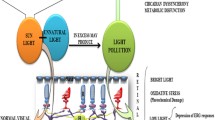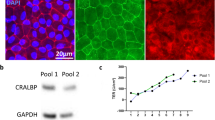Abstract
• Background: The effect of visible light on human retinal pigment epithelial (HRPE) cells has not been characterized under conditions that provide strict thermal control. • Methods: HRPE cells were isolated and grown to confluence. Cells were exposed to light in an incubator in which the cell temperature was controlled in response to a temperature sensor maintained in the tissue culture medium. Cells were exposed: (A) for 24, 36, and 48 h; and using a 24-h exposure followed by 24 h darkness; (B) at varying intensities of light using neutral density filters; (C) under a yellow filter; and (D) with a 12-h on-off cyclic light. • Results: (A) Light exposure of 36 and 48 h resulted in significant cytotoxicity, while the initial 24-h exposure did not induce subsequent cytotoxicity. (B) Light irradiance levels from 43 to 54 mW/cm2 were required to demonstrate cytotoxicity. (C) Use of a yellow filter did not eliminate the observed cytotoxicity. (D) Cyclic exposure did not result in significant cytotoxicity. • Conclusion: This study establishes a model and basic parameters of light toxicity to HRPE cells in vitro using strict temperature control that may be used to evaluate photochemical injury to HRPE cells.
Similar content being viewed by others
References
Alvgere PV, Torstensson PL, Tengroth BM (1993) Light transmittance of ocular media in living rabbit eyes. Invest Ophthalmol Vis Sci 34:349–354
Blanks JC, Pickford MS, Organisciak DT (1992) Ascorbate treatment prevents accumulation of phagosomes in RPE in light damage. Invest Ophthalmol Vis Sci 33:2814–2821
Bressler NM, Bressler SB, Fine SL (1988) Age-related macular degeneration. Surv Ophthalmol 32:375–413
Crockett RS, Lawwill T (1984) Oxygen dependence of damage by 435 nm light in cultured retinal epithelium. Curr Eye Res 3:209–215
Cruickshanks KJ, Klein R, Klein B (1993) Sunlight and age-related macular degeneration, the Beaver Dam eye study. Arch Ophthalmol 111: 514–518
Ferris FL III (1983) Senile macular degeneration: review of epidemiologic features. Am J Epidemiol 118: 132–151
Friedman E, Kuwabara T (1968) The retinal pigment epithelium. IV. The damaging effects of radiant energy. Arch Ophthalmol 80:265–279
Fuller D, Machemer R, Knighton RW (1978) Retinal damage produced by intraocular fiberoptic light. Am J Ophthalmol 35:519–537
Green WR, Robertson DM (1991) Pathologic findings of photic retinopathy in the human eye. Am J Ophthalmol 112:520–527
Hansson HA (1971) A histochemical study of cellular reactions in rat retina transiently damaged by visible light. Exp Eye Res 12:270–274
Klein B, Klein R (1982) Cataracts and macular degeneration in older Americans. Arch Ophthalmol 100: 571–573
Lerman S (1984) Biophysical aspects of corneal and lenticular transparency. Curr Eye Res 3: 3–14
Mainster MA, Ham WT, Delor FC (1983) Potential retinal hazards: instruments and environmental light sources. Am J Ophthalmol 90:927–932
Noell WK, Walker VS, Kang BS et al. (1966) Retinal damage by light in rats. Invest Ophthalmol 5:450–473
Organisciak DT, Darrow RM, Noell WK et al. (1995) Hyperthermia accelerates retinal light damage in rats. Invest Ophthalmol Vis Sci 36:997–1008
Parver LM (1991) Temperature modulating action of choroidal blood flow. Eye 5:181–185
Parver LM, Auker CR, Carpenter DO (1980) Choroidal blood flow as a heat dissipating mechanism in the macula. Am J Ophthalmol 89:641–646
Parver LM, Auker CR, Carpenter DO et al. (1982) Choroidal blood flow II. Reflexive control in the monkey. Arch Ophthalmol 100: 1327–1330
Parver LM, Auker CR, Carpenter DO (1983) Choroidal blood flow. III. Reflexive control in human eyes. Arch Ophthalmol 101: 1604–1606
Sliney DH (1984) Quantifying retinal irradiance levels in light damage experiments. Curr Eye Res 3: 175–179
Taylor HR, West S, Munoz B et al. (1992) The long-term effects of visible light on the eye. Arch Ophthalmol 110:99–104
Tso M, Fine B, Zimmerman L (1972) Photic maculopathy produced by the indirect ophthalmoscope. I. Clinical and histopathologic study. Am J Ophthalmol 73:686–699
Weale RA (1985) Human lenticular fluorescence and transmissivity, and their effect on vision. Exp Eye Res 41:457–473
Author information
Authors and Affiliations
Additional information
The authors have no proprietary interest in any drug or piece of equipment used in this study
Rights and permissions
About this article
Cite this article
Olsen, T.W., Sternberg, P., Reed, R.L. et al. A model for light toxicity of cultured human retinal pigment epithelium. Graefe's Arch Clin Exp Ophthalmol 235, 111–117 (1997). https://doi.org/10.1007/BF00941739
Received:
Revised:
Accepted:
Issue Date:
DOI: https://doi.org/10.1007/BF00941739




